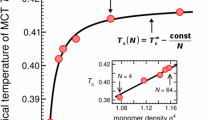Abstract
It is shown that, in the melts of linear macromolecules, the effects of dynamic heterogeneity associated with the presence of end segments are not vanishingly small in the limit \(N \to \infty \), where \(N\) is the number of Kuhn segments in the macromolecule. The effect has a frequency nature, i.e., the division of the segments into “end” ones, more mobile in comparison with the “median” ones, mainly depends on the observation time. With the increase in the observation time, symmetrical growth of the “end” regions of the polymer chain occurs from both ends of the macromolecule which covers the entire macromolecule at times on the order of the terminal relaxation time. The effect generates nontrivial experimentally observed consequences. For example, the free induction decay of deuterons in monodisperse polymer melts of macromolecules should have an extended region with the exponential decay law \(g(t) \propto {{t}^{{ - \beta }}}\), where \(\beta = 1\) for the reptation model and \(\beta = {{(\alpha - 2)}^{{ - 1}}}\) for isotropic renormalized Rouse models: \(\alpha > 2\) is the exponent of the molecular weight dependence of the terminal relaxation time of macromolecules. At \(\alpha \leqslant 2\), the influence of the effects of dynamic heterogeneity on the shape of free induction decay is weaker, although it is observable at sufficient accuracy of the measurements.

Similar content being viewed by others
REFERENCES
A. Yu. Grosberg and A. R. Khokhlov, Statistical Physics of Macromolecules (Nauka, Moscow, 1989) [in Russian].
Yu. Ya. Gotlib, A. A. Darinskii, and Yu. E. Svetlov, Physical Kinetics of Macromolecules (Khimiya, Leningrad, 1986) [in Russian].
M. Doi and S. F. Edwards, The Theory of Polymer Dynamics (Clarendon Press, Oxford, 1989).
P. G. De Gennes, Scaling Concepts in Polymer Physics (Cornell Univ. Press, Ithaca, 1979).
R. Kimmich and R. Bachus, Colloid Polym. Sci. 260, 911 (1982).
T. W. M. Huirua, R. Wang, and P. T. Callaghan, Macromolecules 23, 1658 (1990).
M. Doi, J. Polym. Sci., Polym. Lett. Ed. 19, 265 (1981).
R. Kimmich and M. Köpf, “Contour-Length Fluctuation of Polymers: NMR Experiments and Statistical Physics,” in Progress in Colloid and Polymer Science, Ed. by H.-G. Kilian and G. Lagaly (Steinkopff-Verlag; Springer-Verlag, Darmstadt; New York, 1989), Vol. 80, p. 8.
R. Folland and A. Charlesby, J. Polym. Sci., Polym. Lett. Ed. 16, 339 (1978).
W. L. F. Gölz and H. G. Zachmann, Macromol. Chem. Phys. 176, 2721 (1975).
G. C. Berry and T. G. Fox, Adv. Polym. Sci. 5, 261 (1968).
M. L. Trutschel, A. Mordvinkin, F. Furtado, L. Willner, and K. Saalwächter, Macromolecules 51, 4108 (2018).
D. A. Markelov, M. Dolgushev, and E. Lahderanta, Annu. Rep. NMR Spectrosc. 91, 1 (2017).
M. Dolgushev, D. A. Markelov, F. Fürstenberg, and T. Guérin, Phys. Rev. E 94, 012502 (2016).
D. A. Markelov, F. Fürstenberg, and M. Dolgushev, Polymer 144, 65 (2018).
M. Bixon and R. Zwanzig, J. Chem. Phys. 68, 1896 (1978).
Yu. Ya. Gotlib and Yu. E. Svetlov, Polym. Sci., Ser. A 21, 1531 (1979).
M. G. Bawendi and K. F. Freed, J. Chem. Phys. 83, 2491 (1985).
J. B. Lagowski, J. Noolandi, and B. Nickel, J. Chem. Phys. 95, 1266 (1991).
R. G. Winkler, P. Reineker, and L. Harnau, J. Chem. Phys. 101, 8119 (1994).
B. Y. Ha and D. Thirumalai, J. Chem. Phys. 103, 9408 (1995).
R. Kimmich and N. Fatkullin, Adv. Polym. Sci. 170, 1 (2004).
M. A. Krutyeva, N. F. Fatkullin, and R. Kimmich, Polym. Sci., Ser. A 47, 1022 (2005).
N. F. Fatkullin, T. M. Shakirov, and N. A. Balakirev, Polym. Sci., Ser. A 52, 72 (2010).
K. S. Schweizer, J. Chem. Phys. 91, 5802 (1989).
N. Fatkullin, A. Gubaidullin, C. Mattea, and S. Stapf, J. Chem. Phys. 137, 224907 (2012).
R. Kimmich and N. Fatkullin, Prog. Nucl. Magn. Reson. Spectrosc. 101, 18 (2017).
N. Fatkullin, S. Stapf, M. Hofmann, R. Meier, and E. A. Rössler, J. Non-Cryst. Solids 407, 309 (2015).
R. Kimmich, NMR: Tomography, Diffusometry, Relaxometry (Springer Science and Business Media, Berlin; Heidelberg, 2012).
A. P. Prudnikov, Yu. A. Brychkov, and O. I. Marichev, Integrals and Series (Fizmatlit, Moscow, 2003), Vol. 1.
T. N. Khazanovich, Vysokomol. Soedin. 5, 112 (1963).
N. F. Fatkullin, T. Körber, and E. A. Rössler, Polymer 142, 310 (2018).
Author information
Authors and Affiliations
Corresponding author
Additional information
Translated by E. Boltukhina
Rights and permissions
About this article
Cite this article
Ostrovskaya, I.K., Fatkullin, N.F. The Effect of the End Segments on the Dynamics of a Polymer Melt: The Frequency Nature of the Effect and Possibility of Experimental Observation in the Free Induction Decay of Deuterons. Polym. Sci. Ser. A 62, 132–139 (2020). https://doi.org/10.1134/S0965545X20020030
Received:
Revised:
Accepted:
Published:
Issue Date:
DOI: https://doi.org/10.1134/S0965545X20020030



